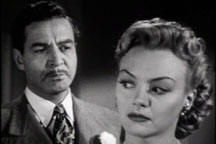|
Jay Fenton on 'Blonde
Ice' At the time of its release in 1948, the scant reviews of BLONDE ICE condemned the title by saying "it's not a nice film.” It belonged to that obscure realm of “B” films noir in which a woman is shown totally grasping and willing to use any means--------including murder------to get what she wants. Claire isn’t interested in the typical virtues of the 40’s woman such as love, family, motherhood, etc. She is overwhelmingly obsessed with money and position to the point of psychosis. Americans prefer to think of criminals as “sick” rather than evil and her sickness provided the element of punishment necessary to the movie's moral code of good always triumphing over evil. |
|||
 |
|||
| It's star, Leslie Brooks, was a second lead---a leading lady, but in “B” or “second features, which occupied the bottom half of a double feature. She had relatively small parts in such “A” films as ZIEGFELD GIRL, YOU WERE NEVER LOVELIER, YANKEE DOODLE DANDY, and COVER GIRL, but could shine in “B” films like TWO SENORITAS FROM CHICAGO, WHAT’S BUZZIN’ COUSIN and I LOVE A BANDLEADER. BLONDE ICE was her last film before retirement. While her acting ability gave Katherine Hepburnnd Bette Davis few sleepless nights, she is absolutely right for this part. | |||
|
Two
things make BLONDE ICE a real find. One is the highly professional
cast of character actors surrounding leads Brooks and Robert
Paige. The 30’s and 40’s were the great era of the
character actor. They were cast in the same part over and over
again so that whenever they walked on the screen the audience knew
exactly what their personalities would be. There was James
Griffith, the catty, intrusive “bitch in trousers”; Walter Sande, the
loyal, good-natured best friend of the hero; James Whalen, the dignified
politician who always seemed to fall in love unwisely; and David
Leonard, the kindly but suspicious psychiatrist with the hint of a
German accent. It was a simpler era when audiences liked
“types” and found them the easiest to accept on the screen. It
also helped reinforce the very satisfying human idea that a person’s
personality was directly related to his appearance. The other outstanding quality of BLONDE ICE is the cinematography by George Robinson, one of Universal’s most gifted “house” cameramen, who was responsible for the menacing atmosphere of DRACULA’S DAUGHTER, FRANKENSTEIN MEETS THE WOLFMAN, Universal’s Spanish language version of DRACULA, etc. Who better than an expert in horror films to show the human monsters of film noir? |
 |
||

